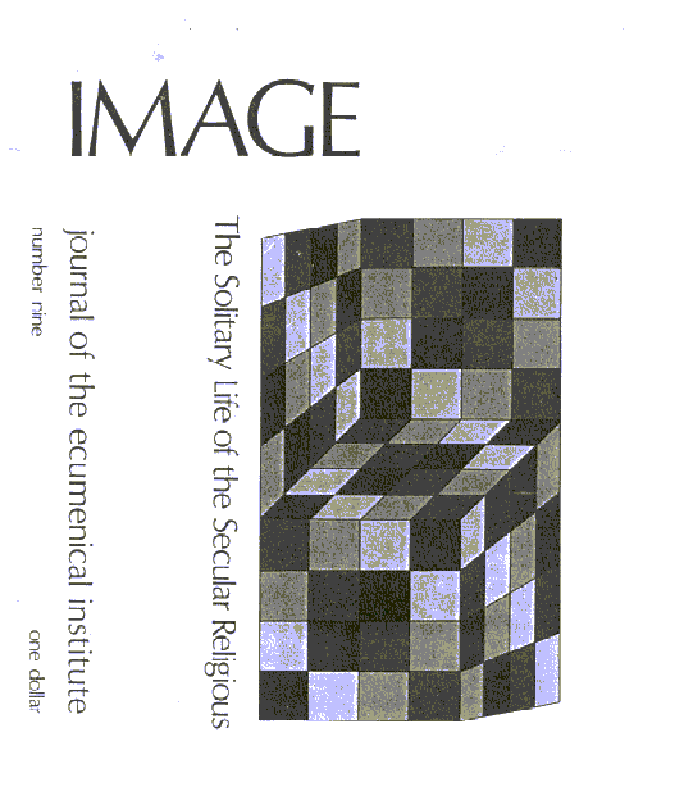

IMAGE is copyrighted by The Ecumenical Institute,
a division of the Church Federation of Greater Chicago. The Ecumenical
Institute was founded by concerned citizens and churchmen as a
result of a resolution offered in the Second Assembly of the World
Council of Churches at Evanston in 1954. It is a notforprofit
organization chartered by the State of Illinois. The institute
is dependent for support upon gifts, deductible for tax purposes,
from individuals, corporations, religious bodies and foundations.
IMAGE is an occasional journal. It is intended to provide the reader with the insights, models and methods that have emerged directly from the Institute's fifteen years of experimentation and research in contextual reeducation, social reformulation and human motivation. Each issue is an IMAGE of a style of life for the universal human citizens of tomorrow's world. Price: $1.00.
Additional copies $.50 each.
NUMBER NINE JUNE, 1970
COPYRIGHT 1970 BY THE ECUMENICAL INSTITUTE
The publication of this issue of IMAGE is a sign
of a major turning point in the life and work of the staff of
The Ecumenical Institute and in the course of the Church in the
twentieth century. In the last two years the staff of the Institute,
as a research body on behalf of the whole Church, has been struggling
with the implications of the global cultural crisis as it has
been illuminated by recent events that have shattered the composure
of every human being who is sensitive to what is going on. Such
events have signaled the collapse of the optimistic social activism
that characterized the mood of the Church in the sixties.
Today the man of faith is raising again the deep
questions of human destiny that drive him back to reflect on his
interior solitary existence. And it is here that he experiences
the confusion and frustration that illuminate the depth human
need to recontextualize all over again what it means to
pray in the twentieth century, or better, what it means to be
a religious man in a totally secular context. Every man knows
that prayer is not some kind of spiritual magic. The crucial need
is to rediscover what prayer is.
The deep question of what it means to create a new
secular piety for the twentieth century religious man has compelled
the research staff of The Ecumenical Institute to undertake a
depth examination of the devotional life of the individual, or
the solitary religious practices of meditation, contemplation
and prayer. The theoretical research and practical experimentation
in the corporate life of the staff have been systematically organized
in the following document on the solitary religious life. This
issue of IMAGE is offered, however, not as a presentation of completed
research in the form of a finished model, but rather as an invitation
to participate along with us in the shaping of the new religious
mode of existence through the creation of a solitary office that
orders the solitary life of every man. This document, in its present
form of a working paper, is offered to our friends and colleagues
who have deeply struggled with prayer in their lives as a crucial
dimension of being human.
The chaos of our times demands that spirit men forge
out methods to enable the emergence of the spirit dynamic in every
human life. The research of the Institute in the religious dimension
has since its beginning dealt with the practical methods of enabling
human spirit decisions. The imperative to share this particular
aspect of the continuing research reflects the demand in our day
to create the new religious life style for the new global man.
We urge your own participation in responding to this
imperative through your own practice of the solitary office and
we invite your comments on the document particularly in the light
of your own experience.
THE NECESSITY OF THE SOLITARY
THE TASK OF THE RELIGIOUS
1. Man in the twentieth century aha experienced a
profound alteration in the basic images of reality by which he
lives. As he encounters explosive change across the globe, he
cannot escape the awareness that the new world has called radically
into question every political and economic system and every symbolic
universe that has sustained human society in the past.
2. The crisis of today is a crisis inhumanness itself.
It raises the question of what it means to be a human being who
is present to the sheer mystery of his existence in a universe
radically different from the past. It demands that humanness be
invented anew through the creation of symbols which articulate
man's experience of his relationships.
3. The signal contribution of religion in any era
is in its invention of humanness. Authentic religion offers recognition
of final mystery: it articulates that "otherness" man
is finally faced with. It offers man a symbolic universe as a
context for dealing self-consciously with his life experience.
Authentic religion creates a story which articulates the secret
of fully human existence. It becomes the life story by which selfhood
or un-selfhood is measured. Authentic religion creates a life
style that relates man's self-understanding to his practical decision-making.
4. The form in which humanness is articulated is
the religious metaphor or poetic image that is born from the consciousness
of one's consciousness-form the process of reflecting on one's
self-awareness. It is the primordial of Ur image which
captures for a particular cultural ethos a mode of existence in
relation to man's encounter with the mysteriousness ofd life.
The primordial Ur image bridges the gap between one's idea
of life and his practical life decisions, allowing one's subjective
response to the synthesized with the objective situation in a
concrete life response.
5. The task of the religious, the People of God,
is to create humanness out of chaos. The religious must perceive
the chaos of the time and out of his selfconsciousness must
construct the life metaphor that articulates a religious mode,
or a way for every man to be human in the midst of history.
THE NEW RELIGIOUS MODE
6. Man in the twentieth century is becoming aware
of a basic mutation in human consciousness and thus in the basic
Ur images that have defined humanness. For the first time
in history mankind is experiencing a universal upheaval in consciousness:
every continent, every people, every individual, and every stage
of life is affected. For the first time in history man is aware
that he creates his own selfconsciousness. This mutation
in humanness was born out of the global cultural revolutions of
the twentieth century.
7. The revolution in common sense has given man a
scientific comprehension of the universe and altered his images
of human participation in it. The revolution in common style has
shifted the basic orientation of man from images reflecting past
patterns to the creation of future possibilities. Under the impact
of accelerating social change the simple rhythms of nature, the
intimate, and the provincial have given way to the complexity
of historical variation, the anonymous, and the comprehensive.
Today the entire world is an emerging cosmopolis in form and mentality.
The revolution in common mood of man has replaced the assumed
authority of the past with intentional temporal models forged
out of the insight of the times as a means of determining the
future.
8. Man in the twentieth century experiences the demand
to create his own future by creating his own selfconsciousness,
and thus the demand for a new religious mode of existence articulated
through the self'conscious transformation of the basic Ur
images by which he lives. He is aware that he has grasped
his hunnanness out of a particular prirnordial invention which
is only one of' several Ur images emphasizing different,
though equally significant, aspects of what it means to be human.
This awareness is the first step in creating a new, universal
invention of humanness embodying the gifts of all the Ur images
in a new religious mode.
9. A religious mode, in any age, is that ethos of
a time and a people by which man is related to the final mystery
of existence itself. It is that style out of which his every relationship
is defined. It is that ground out of which he is enabled to forge
his own particular self'understanding. The religious mode
demanded in the last third of the twentieth century is for the
first time not the mode of a people but the most of all peoples.
Nothing less than a universal religious mode is demanded of our
time.
10. Every religious node is expressed concretely
in social structures, or it becomes an esoteric system or abstraction
that is not a mode of existence. A religious mode is embodied
in the social vehicle which holds it in being. In order to change
a given complex of social structures it is necessary to revolutionize
the mindset which sustains it. It is the transformation of human
spirit through the bringing into being of a new religious mode
which gives man permission to invent a new social vehicle.
11. Today the demand upon every human being is to participate in creating the new global political, economic, and cultural structures of a social vehicle that will offer the possibility
of humanness to every man. Those men of the spirit who respond to this demand - the
People of God - know that the only strategy that will make possible the creation of a new
social vehicle for the globe is the intentional creation of a new religious mode that is the spirit revolution itself. The decision to embody this new religious mode in one's solitary
being, his corporate being, and his spirit journey is that without which nothing new is
created in history.
THE SOLITARY OFFICE
12. Every man in our age, regardless of his social
and religious context, stands present to the totality of existence
in three fundamental ways. He is driven to order the chaos that
surrounds him, to extend his consciousness to the edge of the
knowable, to continue his journey of increasing the sphere of
consciousness. He is also driven to accomplish, to give meaning
to his life through participation in society, to grasp his significance
as related to everbroadening the scope of his action.
13. Yet knowing and doing are finally not adequate ways of describing man. He discovers in knowing that he knows nothing, and that all of his knowing throws him over the abyss. He
grasps all his doing as impotent, and thus all his
doing throws him over the abyss. He is the one who is unsynonymous
with his knowing and his doing, yet his being is the intensification
of both which utterly transforms them. Man's being is a style
whereby he stands present to all of his life and therein creates
history - a style which in our day is that of transparency.
| These facts are imperious; they cannot be wished away. They cannot be prayed or cursed out of existence. It is as futile to ignore them as to run away from them. We have no choice, then, but to come to terms with them. It is surely clearer every day that the times have caught up with us but we have not caught up with the times.
-John Cogley What is needed is a chance to rearrange the elements of the Western vision. -Carl Oglesby |
| We will not reach that goal today or tomorrow. Perhaps we will not reach it until the end of our life. But seeking it is the greatest adventure of our age. We may be impatient at times with the weight of our obligations, the complexity of decision, the agony of choice. But for us there is no comfort or security in evasion, no solution in abdication, and no release in irresponsibility.
-John F. Kennedy It is the loneliness of a man who knows he will not live to see the mystery of life solved, and who, furthermore, has come to believe it will not be solved when the first humanly synthesized particle begins-if it ever does-to multiply itself in some unknown solution. It is really a matter, I suppose, of the kind of questions one asks himself.
-Loren Eiseley The judgment of the future upon the present is not a matter of claiming allegiance to certain abstract eternal values or ideals, but of quite specific technological and political goals. They are defined and given concreteness in the midst of the dialogue between our vision of man and of what he can become and tile situation in which we find ourselves. -Richard Shaull | 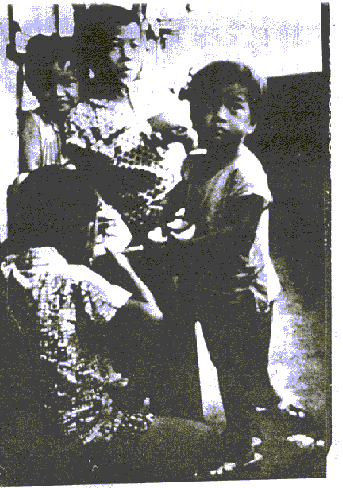
|
14. Man in the twentieth century experiences his
existence as radical discontinuity with all he has known, done,
or been. As he faces the collapse of his knowing and the frustration
of his doing, he is driven to raise the question of his being
anew out of the explosion of new depths in his selfconsciousness.
Every human being has been thrown into a depth struggle against
the primordial mystery at the center of life itself. That struggle
is finally a solitary struggle in which the new face of God is
created by man's solitary primal decisions and those alone.
15. Humanness always manifests itself in myth, rite,
and symbol which hold any religious mode in being and are manifestations
of that mode. Man in the twentieth century, having been thrown
into his solitary struggle with the mystery of his existence,
experiences with every solitary man in history the demand to forge
a solitary office which will hold him before the white hot intensity
of the final mystery.
16. The solitary office is that human act that is
at the very core of both the religious mode and the social vehicle
of the times. It is a particular enactment whereby the religious
mode is created and sustained. The myths, rites, and symbols of
a people are discovered anti created by those human beings who
shape the consciousness of a time and place. At the same time
the religious mode is the primary context in which a solitary
office is performed; the office itself is informed by and takes
its shape from the mode in whicl1 it is enacted. The Moslem shalom
six times a day could come into being only in the Islamic religious
mode.
17. The solitary office is simultaneously that human
act whicl1 creates and sustains the social vehicle of a people.
As that unique, unrepeatable act of the will is performed, it
concretizes the religious mode in selfhood, demanding a spirit
decision to create a new politics, economics, education, symbol,
and style. The social vehicle in turn prescribes the context within
which that spirit decision is forged. The psychotic is the person
whose solitary is out of step with his society. Revolution takes
place by means of those solitaries done on the rim of the psychotic
abyss, unrelated to the social vehicle of the day, while at the
same time the revolutionary remains utterly a part of that vehicle.
The solitary office is the core of the spirit discipline of the
People of God at any given moment in history, and manifests itself
in a covenantal rule with colleagues and reality itself.
18. Man in the twentieth century stands as a solitary Being before the awesome task of creating that which never was. The solitary office is that spirit exercise by which he decides to be the being that history demands.
THE GROUND OF THE SOLITARY OFFICE
19.
and in Oriental civilization in the short space of
twenty years human spirit has created Communist China. It was
the solitary by which Mao Tsetung lifted the Chinese nation
from feudalism to the point of capturing the imagination of the
voiceless people of the world.
EXISTENTIAL GROUND
21. The solitary is that human act whereby history
itself is forged. Although history is finally created only
by a body of individuals who unite themselves in a common deed,
it is the individual's spirit decision that gives particular shape
to human life. Every decision has its own unique form, and that
form is determined in the act of the solitary. Human beings are
basically related to raw existence or nature, to society or other
human beings, and to the spirit dimension or the matrix of intentionality.
As a people who have decided to stand before the final mystery-the
enigmatic power that drives man this way and that-the solitary
People of God call that power Father, taking a relation to that
power as the source of their very being. The solitary is that
act that releases man from all those vain irnaginings that draw
him away from that life decision. As a people who have decided
to embrace their lives as they are exposed by that event that
destroys their illusions about life the People of God know that
their real life is affirmed in the Word of that event. The
solitary is that act whereby all other words about life are relativized
and made subservient to the Word. As a people who have decided
to live out their lives as utterly free people who are utterly
obedient to the way life is, the People of God are thus finally
responsible for forging the destiny of mankind. The solitary
is that act whereby they individually actualize that responsibility.
PHENOMENOLOGICAL GROUND
22. In the deeps of human existence the solitary deals with the relationship which human beings take to the structure of beinginitself. Man becomes human only before the final mystery of life that is totally unsynonymous with his existence. Humanness begins at the moment a human being is faced with the dread of nonbeing. When man faces the fact of his death-that his existence is nothing more than a burst of energy into the great abyss- then it is that he becomes human. It is by means of the solitary that he faces nonbeing concretely. All abstract considerations of death in the world do not enable man to be the human being that he is. The solitary is an act of the will hereby man looks clearly at his death and therefore at the death of all things. And that death is dreadfilling. But he also emerges as a conscious being before the dread of being. The depth human fear that all human
Ho! Ye Sun, Noon, Stars.
all that move in the heavens,
I bid you hear me!
Into your midst hath come a new life
Consent ye, I implore!
Make its path smooth,
that it may reach the brow of the first hill.
Ho! All ye of the heavens.
All yue of the air, all ye of the earth.
I bid you all hear me!
Into your midst hath come a new life.
Consent ye all, I implore!
Make its path smooth.
then shall it travel beyond the hills.
-Onlalla Indians
'Touch ultimate emptiness,
Hold steady and still.
All things work together.
When you know
What eternally is so,
You have stature
And stature means righteousness.
And righteousness is kingly
And divinity is the Way
Which is final.
Then, though you die,
You shall not perish.
--Lao Tzu
lives is the fear of the "justthereness"
of life. Alan is always going about imagining that one day he
will live, that today he is not yet living. But the way life is
is that his life is his life just as it is given. When he faces
that, he lives. The solitary is that act by which man brings his
total attention, his total existence to bear on the facticity
of his life. When this occurs, new life or resurrected life, life
in all its fullness, rushes into his existence. This experience
in life is the deepest dread of all, as man sees that he is in
fact a new man. The man of faith knows that his only choice is
suicide or crucifixion. The solitary is that act by which he makes
that decision over and over again. And yet in the midst of the
dread of life, humanness emerges at the same time as a depth fascination
before the final mystery. As a human being faces the primordial
chaos, he is utterly fascinated by nonbeing. Man faces his
death and becomes absorbed with dying that death. The solitary
is that act whereby he moves into that absorption. Humanness also
comes to be when man faces his "showedup-ness"
and becomes utterly fascinated by being, or by creation itself.
His task is to respond to that fascination with death and showedup-ness
by affirming, a world in perpetual change. To speak confessionally,
it is only in his response, his eager response to the Lord of
history, that man becomes a full human being. This response is
the solitary. In dread and fascination is found the creep human
awe that enables human beings to be human. The solitary office
is an individual rite which confronts man with the nothingness
of life as well as the something-ness of life. Awe is experienced
before everything that is when man stands as fully human. The
solitary deals with the phenomenology of all existence, and in
so doing creates life in all its manifestations.
CONCLUSION
23. The secular, revolutionary, and universal world
of the twentieth century demands that man today bring into existence
a new solitary office. The imperative of the transmutation of
consciousness-whereby man consciously forms his own consciousness
-- is the imperative to create a new symbolic life. The solitary
office is the center of that new consciousness of consciousness
of consciousness. The secular world demands that man intentionally
forge out those symbols and patterns of relationships which allow
him to decide his own life freely as he knows it grounding in
all of history. The revolutionary world demands that man constantly
forge new structures of civilization within a corporate group.
The new solitary office must enable the revolutionary stance.
It must also enable man to participate as a universal man by being
the source and expression of his decision to stand before the
mystery in the Word that all of life-all of creation-is received
and good as it is. The symbolic life of the solitary is that which
will finally sustain the secular, revolutionary, and universal
which is humanness itself.
INTRODUCTION
24. Three fundamental dimensions of man's solitary
struggle have formed his solitary office throughout the ages.
In contemplation man encounters the abyss in which he stands utterly
present to the final mystery at the center of life. In meditation,
an encounters a host of colleagues in the solitary struggle, allowing
their insights to inform his struggle. In prayer, man encounters
the demands of history, lifting before his gaze the past and present
as they focus on the future of civilization and assuming responsibility
for all that will be.
25. The construct of the solitary office corresponds
to the solitary experience of life in which man grasps after the
deeps of existence through the human activities of meditation,
contemplation, and prayer. Though these activities intermingle
in life and are interrelated in the solitary office, they are
here treated as three distinct entities, designed intentionally
to hold man present to the totality of life. The task of creating
consciousness in the twentieth century always requires comprehensive
structuring of the symbolic life, which exposes man to the depth
and breadth of human experience as he encounters the primordial
deeps and the enigmatic future.
26. As man faced the assault of the future which
demanded life and death decisions of him, one of the ways he coped
with this demand to face the unknown was through reflecting on
the wisdom of his "ancestors." Every man has ancestors
whose lives, deeds, and sayings inform his imagination and consciousness.
To meditate is to reflect selfconsciously on one's actual
and projected relation to those who inform his imagination. The
issue for man in the twentieth century is disclosed in the fact
that he is free to create his own conscience, to choose who will
and who will not be his imaginal ancestors.
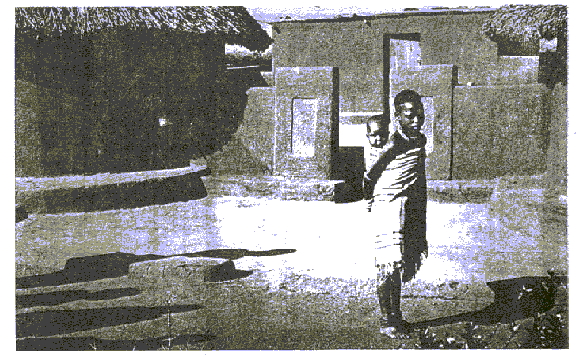
|
| If it had been a question in my lifetime of choosing a spiritual guide, a guru as the Hindus say, a father as say the monks at Mount Athos, surely I would have chosen Zorba. I watched Zorba dance and whinny in the middle of the night, heard him call me to leap up in my own turn from the agreeable heaven of prudence and custom in order to depart with him on great voyages from which there was no return, and there I sat, motionless and shivering. I have been ashamed many times in my life because I caught my soul not daring to do what supreme folly-the essence of life-called on me to do. But never felt so ashamed of my soul as I did in front of Zorba. -Nikos Kazantzakis | At that time I had a chance to read Thomas Merton's autobiography. Despite my rejection of Merton's theistic world view, I could not keep him out of the room. He shouldered his way through the door. Welcome, Brother Merton. 1 give him a bear hug. Most impressive of all to me was Merton's description of
New York's black ghetto-Harlem. I used to keep his passage in mind when delivering lectures to other prisoners. Whenever I felt myself softening, relaxing, I had only to read that passage to become once more a rigid flame of indignation. I vibrate sympathetically to any protest against tyranny. -Eldredge Cleaver |
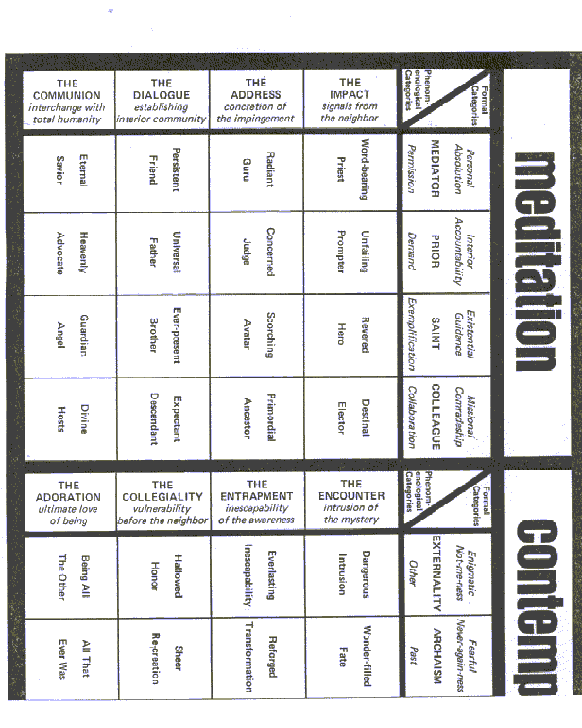
|
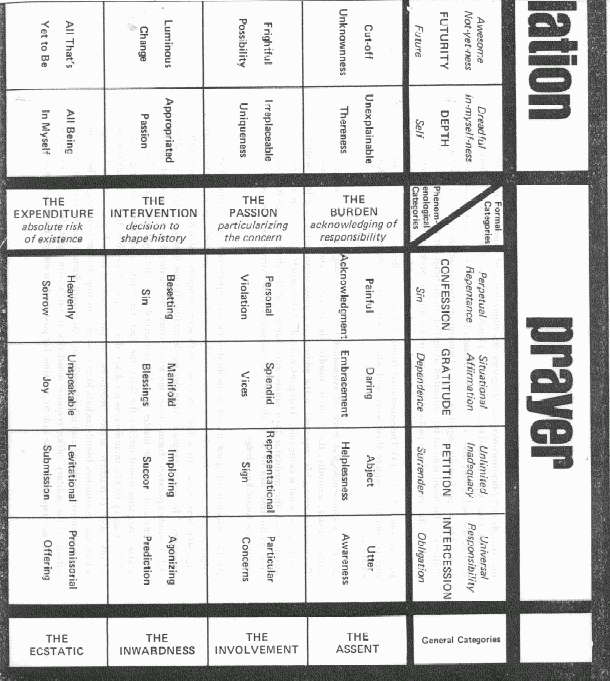 |
27. The construct for meditation includes both formal
categories for identifying and selecting friends and phenomenological
categories describing levels of experience in meditation. There
are four types of meditative friends: (1) Permissiongiving
friends act as Mediators of the ChristWord, giving
man unlimited permission to appropriate the horror and possibility
of his life as profoundly significant. (2) Demanding friends act
as Priors or selfchosen "fathers" who recall
man to his unlimited obligation to his neighbor and require that
he be present to the universal and particular demand on his life.
(3) Styleexemplifying friends, ancient and contemporary,
who have embodied a revolutionary life style in forging the future
become one's Saints. (4) Transpositional friends are one's Colleagues
of the past who cry out to him to complete their work and who
depend on his decision for their historical existence.
28. The phenomenological levels of encounter with one's imaginal friends are, first, the initial Impact; secondly, the Address; thirdly, the Dialogue; and finally the Communion. The ever-deepening life responses to the address of friends begin at the first level with the "hearing" of what is being said. Having intentionally held himself open to this address at the second level, the meditator then enters into dialogue at the third level, saying "yes" and "no" as the free man he is. At the level of communion the friends join forces and become one in newfound knowledge.
29. The selection of spirit friends is facilitated
by a comprehensive space/time chart. One might possibly select
friends on a daily, weekly, monthly, or quarterly basis. The typology
suggested here would fit a daily selection, with seven temporal
categories and four spatial categories. The seven temporal categories
would include futuric friends (imagined, e.g. 2050 A.D., contemporaries,
friends from modern history, the medieval period, ancient history,
organic life and inorganic matter from the primordial past, and
mythical friends. The four spatial categories would include the
West, the East, the South, and the Cosmos (e.g. Planet "X"
in Galaxy 0537). Inclusiveness is enhanced in the space/time chart
by the identification of roles such as teachers, actors, intimates,
and the People of God. Types of media through which one encounters
friends include literary works, art objects, and recordings. The
task of comprehensively ordering and intentionally selecting spirit
friends for the practice of meditation in the solitary office
requires sensitivity to one's own spirit deeps, the historical
drama, and especially to the ordering of time for post-modern
man in the secular world.
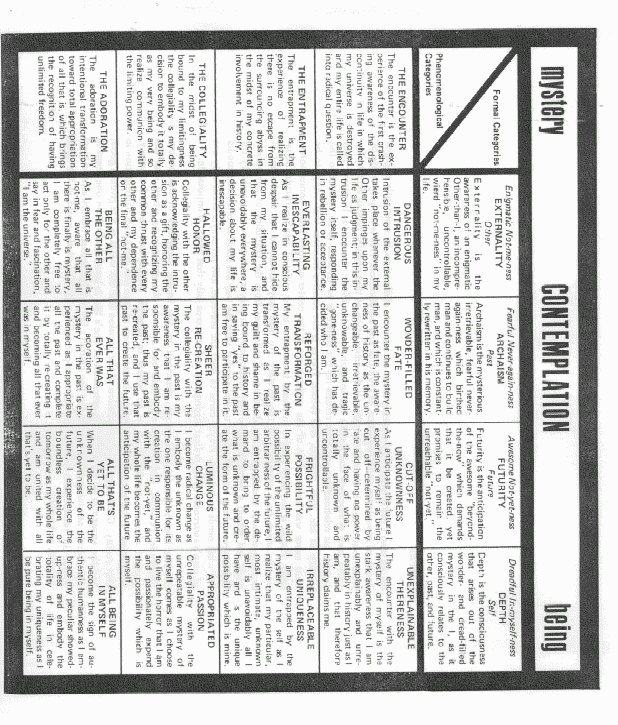
CONTEMPLATION
30. Contemplation is the activity in which the self
probes the depths of its being as beingin-relation to the
mystery of all that is. Contemplation is designed to bring to
consciousness the struggle to be one's being while aware of the
utter objectively of one's encounter with the mystery. The content
and method of contemplation are designed to bring this awareness
to consciousness througl1 the disciplined focus of body, mind,
and spirit on a particular myth, rite, and symbol.
31. The construct for contemplation includes both
formal categories for ordering the reality which is encountered
in the act of contemplation and phenomenological categories describing
levels of experience in contemplation. The attention of the self
is engaged in contemplation of its relationships to the Other,
the Past, the Future, and the Self through
methods which push consciousness beyond rationality to a depth
encounter with the mystery.
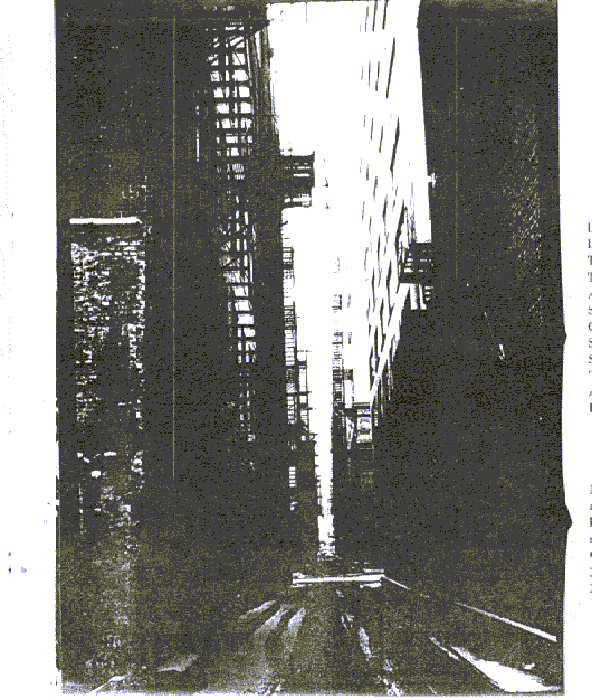
|
I am being driven forward Into an unknown land. The pass grows steeper. The air grows colder and sharper. A wind from my unknown goal Stirs the strings Of expectation Still the question: Shall 1 ever get there? There where life resounds A clear pure note In the silence It occurs to you in a flash; I might just as well never have existed. Other people, however, seeing you with a guaranteed salary, a bank account, and a briefcase under your arm, assume that you take your existence for granted. What you are can be of interest to them, not that you are.
--Dag Hammarskjold |
32. A new consciousness of the self in relation to
the Other may be created by encountering one of the Ur images
expressing the depth of humanness invented by another culture,
through the use of a story or myth from that culture, a rite using
the body in a gesture or posture unique to that people, or a geographical
symbol of that region that enhances global awareness. Alan's perception
of the self in relation to the task and the Future is heightened
as he stands selfconsciously before the totality of time
and space through symbols of another historical period or through
the use of the body in the rhythmic and spatial dimensions of
the dance. This heightened awareness of the self in relation to
the Other, the Past, and the Future brings about an expanded consciousness
of the Self in relation to itself in its knowing, doing,
and being. Through symbols which hold him present to what he knows,
such as a rood screen or montage, man grasps the comprehensiveness
and depth of his knowing. Through contemplation of the effectiveness
of his deeds and through the strain, tension, and pain of extreme
bodily gestures and postures, man senses anew the physical dimension
of the self in its doing. Through the story he tells himself about
who he is in the midst of these relationships and in the midst
of this solitary act as he contemplates his style, his stance,
and his decisions, man struggles to perceive his being. Thus contemplation
increases consciousness of the mystery of the self in relation
to the otherness, the "not-me-ness" of all its relationships.
Methods such as these are not contemplation; they simply create
the possibility of the contemplative act.
33. The phenomenological levels of experience of
one's relationships in contemplation are, first, the Encounter;
second, the Entrapment; third, the Collegiality; and finally the
Adoration. St. John of the Cross wrote a classic description of
what happens in contemplation using the categories of the Preparation,
the Descent, the Dark Night of the Soul, and the Ecstasy. Initially
man encounters anew his life as it is. Struggling again with all
that is there, he knows himself as a strange being of unknown
future and ungracious past. He falls, perhaps, into an immediate
sensing of the offensive dread, the shame, and the emptiness of
the moment. There may follow that raw experience of the painful
uncertainty, the inevitability, and tile total chaos of all being,
which has been called the Dark Night of the Soul. The final awareness
which may sometimes occur is the transfigurational moment in which
all is seen as one through the ecstatic vision (or decision)
that all that is, just as it is, is good. Then life comes together
as one fabric as the solitary office culminates in the transparency
of the self in the ecstatic love of God.
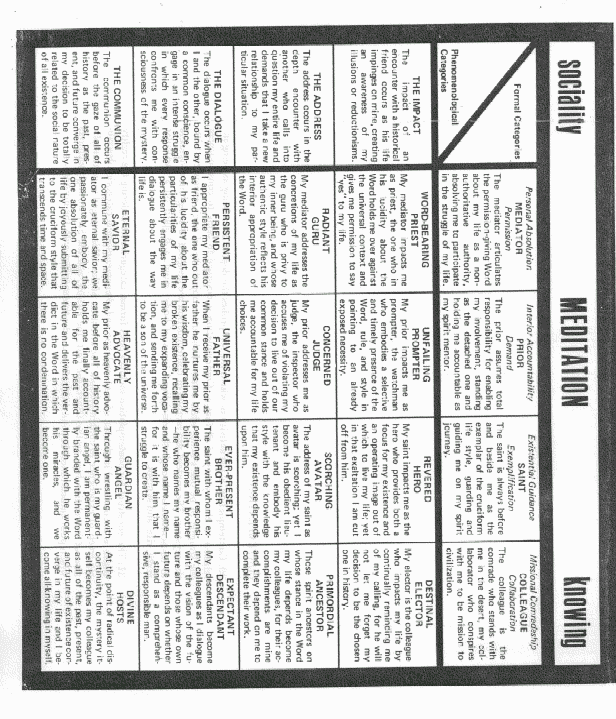
| CONTEMPLATION CHART |
PRAYER
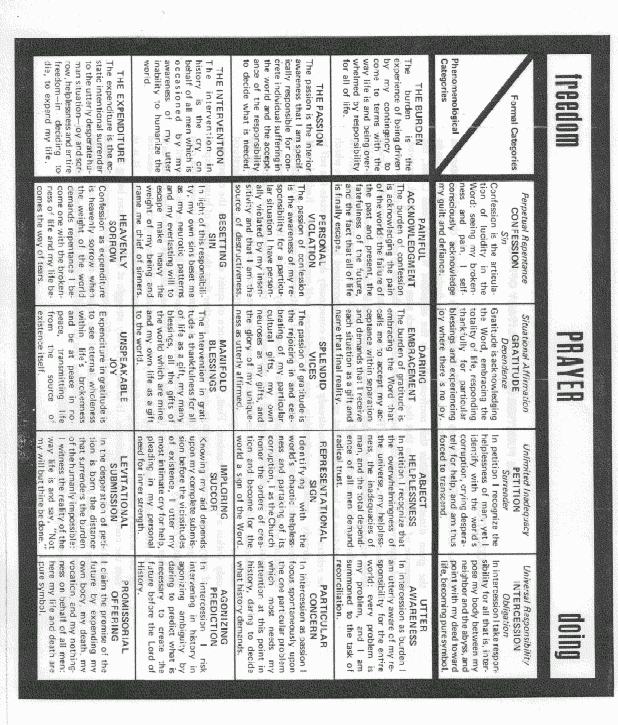
34. As man's life is engaged in creating deeds necessary
to civilization, he constantly engages in acts of repentance and
acceptance, of gratitude and supplication. This is the prayer
life of every man. Prayer in the solitary office is the articulation
of that ongoing human activity by which man symbolizes and orders
the investiture of his life in the world. In prayer man decides
his relationships and thus reveals his life stance as he chooses
to be present to the totality of life, past, present, and future.
Prayer is the creative freedom that brings to be what never was
before. Out of the nothingness at the center of one's being comes
something. Prayer is the deep resolve to create humanness in the
midst of man's particular situation in which he is overcome by
the mystery. No man prays alone; no one creates out of nothing
without standing on the shoulders of colleagues from the beginning
of humanness itself and within a particular historical community.
In prayer man takes responsibility for the future, risking his
selfhood in mortal combat with the way life itself is to create
a model for what needs to happen. Prayer dares to shift the universe,
and yet prayer arises only out of man's awareness of his radical
inadequacy and concerns only that which is impossible.
35. The historic practices of prayer, described by
the formal categories of Confession, Gratitude, Petition, and
Intercession, hold one open to the methods by which man has grasped
after his creatureliness as he relates to himself, others, and
the final mystery. Confession is the acknowledgment of the sinfulness
of man and one's own participation in that reality. Gratitude
is the articulation of the decision that the world as it is given
is good, and the awareness of tile particular givenness of one's
life as good. In Petition one prays as the church, assuming responsibility
for the church's life in its universal, historical, and local
forms. In Intercession the church takes responsibility for the
whole world in the past, present, and future.
36. Through the construct of prayer in the solitary
office man recreates and participates in life at the levels of
experience described by the phenomenological categories of the
Burden of the world, the Passion of engagement, the Intervention
in history, and the Expenditure of life. The Burden is
that of realizing the demands of the world upon the man of faith.
Passion is the awareness that the individual himself is responsible
for what is happening. Intervention is creating a plan for what
is needed in the concrete situation. In expenditure one joyously
gives himself to the realization of that prayer in history. To
pray authentically is to actualize oneself as one thrust in history.
37. To enable the activity of prayer in the selfconscious
practice of the solitary office, men of all cultures and faiths
have used a variety of aids including literary constructs, plastic
arts, rhythmic instruments, and bodily movements. Prayer books
and prayer charts provide a comprehensive model of intercessory
concerns, scheduled systematically to hold man intentionally before
all aspects of life for which he takes responsibility as a man
of faith. The plastic arts provide him with other tools like the
rosary, prayer beads, and the prayer wheel, which serve much the
same function, while rhythmic instruments like the gong, drum,
bell, and rattle provide an emphatic accent to his prayers or
guide him through the stages of his spirit exercises. David's
psalms of praise were often accompanied by the lute or harp which
provided a musical mood or setting for his prayers. Bodily movements
such as postures (bowing, kneeling, sitting crosslegged,
prostration), gestures (bowed head, clasped or uplifted hands,
or outstretched arms), speech (chant, public voice, ecstatic cry,
laugh, moan) and the dance (ecstatic whirling of the dervish)
accent his responses and enable him to express more fully his
deepest struggles as he prays.
CONCLUSION
38. The structure of the solitary office as meditation,
contemplation, and prayer is grounded in man's experience of his
humanness. It enables the secular religious man to struggle selfconsciously
with the depth dimension of his life before the final mystery.
Meditation, contemplation, and prayer serve as an intentional
form by which man in the postmodern world can create his
own consciousness. They are a religious mode of existence for
secular society as it grasps after its real source of power and
creative impulses.
Prayer chart goes here
THE FUNCTION OF THE SOLITARY OFFICE
INTRODUCTION
39. The solitary office confronts man with his actual
life situation as the only context in which he can operate and
requires that he make a solitary decision about his relationship
to the given situation. Within this confrontation is the objective
Word in Jesus Christ, the presence of which proclaims that the
situation in which man finds himself is good, received, and approved.
The Word thus becomes the imperative that he grasp the actuality
of his situation as open to the future. This experience is at
the center of the solitary office. One is never without a relationship
to his situation. Finally one is related concretely to all of
life only through the particularity of his given situation. One's
selfhood or humanness is not the basic relation to his situation,
but rather is ultimately determined by the manner in which he
relates to that basic relation already present. In consciously
deciding to relate the self to the already present relationship
one experiences selfconsciousness. Radical self-consciousness
takes place when one relates to his total relationships out of
the Word in Jesus Christ in which he selfconsciously decides
to stand totally present to the total situation in affirmation
of that situation as good and necessary. This radical experience
is the birth of humanness and its occurrence in human life an
objective fact, but the event which is the birth of true creativity
is the experience of the solitary office itself. This can be understood
only within a threefold context. First, the experience of spirit
encounter is the experience of every man. Every man knows to one
degree or another that the deeps of human experience are to be
lived in every concrete situation, and senses the demand to seize
his own authentic creativity in every situation. The solitary
office allows him to see that his entire life has been one encounter
of the spirit after another and that the remainder of his days
will be lived before that encounter. Secondly, the experience
of human spirit as it is enacted in the solitary office, while
being radical, is a very common, everyday experience. It is in
fact the core of every experience. It is the everyday struggle
at being a human being, that is the setting, for the spirit life.
Finally, the solitary office experience is that experience which
thrusts every man's knowledge to the horizon of the universe,
engages every man's activity in the demands of all of history,
and enables one to stand as a total human being before the unknown
depths of the mystery of life itself.
TRANSPARENT KNOWING
40. The spirit decision which transforms man's relation
to his knowing enables him to spell out withrelative clarity
the scope of the change in knowing, whether it be in general understanding
or in a depth encounter. The new relationship to life in the knowing
dimension is ultimately a shift in one's theological stance, a
result not essentially of any degree of intellectual endeavor,
but rather of the encounter with the Word in Jesus Christ. The
result of reducing the solitary office to some level of intellectual
astuteness is a form of intellectualism. The solitary office is
not primarily an intellectual exercise, but rather a depth reflection
of one's total grasp of his function as a knowing being. A much
more subtle expression of the reduction to merely the intellectual
is what might be called phraseology. This is the reducing of the
reality of the solitary office to metaphors. Metaphors are utterly
necessary for creative reflection in the solitary life, but if
the categories used become tools by which the depth encounter
within the office is blocked, then the dynamic vitality is frozen
in sterile rigidity. In the richness of the solitary, one grasps
his new relationship to life as one of standing present to the
transparency of any system of knowing, being aware of the fact
that knowing always reduces that which is uneducable, that it
orders that which can never finally be ordered, and that it gives
meaning to that which is finally mysterious.
TRANSPARENT DOING
41. The spirit decision which transforms man's relation to his doing brings about theologically grounded activity in an archaic, comprehensive, intentional, and futuric framework. The new relationship to life in the doing dimension implies that concrete action actually takes place in a new way or that a change takes place in the performance of cruciformity. This action, while experienced as a new relationship, is seen in the ChristWord in which doing becomes transparent to life itself, grounded in the given situation, rendered by the totality of the self, and surrendered in the openness to new demands. Too often the solitary is misunderstood as a ritual to justify whatever action a person happens to be engaged in. This is a subtle form of moralism in which the individual believes that if he does the right ritual his doing will be made more effective. The solitary office is not a manipulation for effective social action. Very closely related is the mistaken idea that the solitary is some form of emotional "pep talk" in which the result is a "great feeling," or a psychological comforter in which one's particular problems find miraculous cure. The solitary office may produce a coming to terms with one's life or the decision about living despite one's particular
![]()
psychological blocks, but the office is not designed
for these purposes. Life is not limited to just exciting experiences,
but consists of evernew decisions about how to act out one's
life in relationship to his past in the present situation for
the sake of the future.
TRANSPARENT BEING
42. The spirit decision which transforms man's relation
to his being is finally the forging of a discernible stance which
is selfconsciously conceived in the participation of the
moment and in the midst of the actual life situation. The stance
is the dynamic creating intentional activity in the one who has
appropriated his own death. At the same time it is an authentic
response found only when the deeps of the self are transparent
to the perpetual presence of the mystery of life. Because the
solitary is always deeply grounded in the concretion of an individual's
life, there is a strong temptation to abstract the experience
to a plane of unreality, or to enter what might be called esotericism.
If the contribution of the solitary office is contained within
the office and no selfconscious relation is made to the
givenness of one's life, then the experience is isolated and void
of objectivity. When this objectivity is lost often an individual
will focus on the artifacts or the "beauty" of the experience
itself'. The artifacts are tools and the experience the vehicle
by which regains the necessary objectivity to stand in a new relationship
to his own struggle. This change in stance in the context of the
ChristWord is not simply a realization of a psychic thereness
nor of one's present stance in life, but rather involves a new
decision about how one finally stands present to all of life.
The solitary office enables man constantly to decide his actual
relation to his total situation.
C0NCLUSION
43. The solitary office thus finds its significance
only in the Word in Jesus Christ, which when brought to consciousness
creates new relationships to life. In utilizing the solitary office
one must constantly remember that the office is merely that vehicle
in and through which one is able to bring to selfconsciousness
those alreadypresent possibilities of relating in depth
to the totality of one's experience. There is a dangerously thin
life between this appropriation of the solitary and the many traps
that make the solitary of office a means of reducing one's response
to life. The experience of spirit which is the solitary office
is the uncontrolled leap beyond one's narrow selfimposed
bounds and the ecstatic plunge below the selfdefined shallowness
of the particular situation to the mystery at the depth of all
of life.
POSTSCRIPT
44. The solitary office is finally the method by which human beings
appropriate their own particular myth, rite, and symbols which
enable them to participate in and formulate the time and space
about them. Rather than living out of many stories which he adapts
to the convenience of the moment, man consciously puts together
out of human heritage a cosmic story out of which he can live
fully. Yet no man can construct such a myth willynilly as
he chooses; he constructs or discovers it amid some community
in history. This is finally the eschatological community. But
no one lives in a myth; it is crucial that every man participate
in a rite, a high ritual, through which he is regularly and constantly
held over against the mystery, depth, and greatness of his existence.
The solitary office is such a rite, and it always stands as that
avenue through which his wild interior struggle lives anew through
the cosmic myth. Finally a man cannot maintain his humanness unless
his life is pervaded by symbols. Symbols are those entities from
which there is no escape. They move us beyond the immediacies
of our own particular lives to the boundary of existence itself
in order that the human depths we share with all human beings
can be experienced in every specific encounter of our lives. The
solitary office is at one and the same time the means by which
our myth is retold, our rite is reenacted, and our symbols
are held before us.